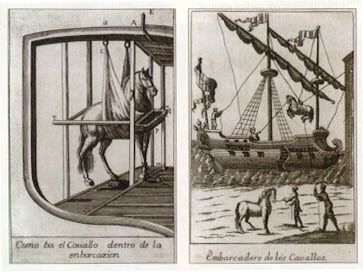|
|
Post by DianneC on Jan 25, 2008 0:41:44 GMT -5
We talk a lot about "old Andalusian" or "old Iberian" I thought it might be fun to find paintings, statues and drawings of Spanish horses in the era between 1550 and 1850 and compare them to the Kiger. Not even sure those are the right dates, just thinking about Columbus in 1492 and giving it a bit of time before lots of horses were imported. The end date is when the "49ers" and lots of people started coming West bringing their horses with them.
What do you think? Could be interesting.
|
|
|
|
Post by fantasykiger on Jan 25, 2008 14:18:16 GMT -5
Oh I think it will be fun to look up old pictures and artist renderings of horses. My first attempt I came across this "Napoleon crossing the Alps"Jacques-Louis David, 1800  Very interesting story, the French victory in Italy allowed for a rapprochement with Charles IV of Spain. While talks were underway to re-establish diplomatic relations, a traditional exchange of gifts took place. Charles received Versailles-manufactured pistols, dresses from the best Parisian dressmakers, jewels for the queen, and a fine set of armour for the newly reappointed Prime Minister, Manuel Godoy. In return Napoleon was offered sixteen Spanish horses from the royal stables, portraits of the king and queen by Goya, and the portrait that was to be commissioned from David of Napoleon. In reality the crossing had been made in fine weather and Bonaparte had been led across, mounted on a mule, by a guide. |
|
|
|
Post by fantasykiger on Jan 25, 2008 15:13:17 GMT -5
Here is another example that is just one of several that can be found on this link www.azteca-horse.com/haca.htmlreminds me of what is described as a claybank Kiger  |
|
|
|
Post by nrly on Jan 25, 2008 15:47:21 GMT -5
yes it does resemble a clay banks, but man what stuff they made those horse's wear. dig that top hat on that horse.
|
|
|
|
Post by desperatehorsewife on Jan 25, 2008 18:22:48 GMT -5
|
|
|
|
Post by JoanMRK on Jan 25, 2008 19:28:50 GMT -5
Yes, the spotted horses were "in" at one point, pretty big. I've seen them in paintings like you've shown. I've also heard of a horse called the knabstrupper (sp?) who is a gaited spotted horse like an appy from Denmark. I wonder if these are what those illustrations are from?
|
|
|
|
Post by desperatehorsewife on Jan 25, 2008 20:40:45 GMT -5
I think the two bottoms ones were labeled Spanish Riding School, which is why I thought I'd put them up. Yes, there was a gaited spotted horse; it mentions that in the link. I didn't read it all real closely as it was chore time and I had got to go out and feed, chip ice, walk to the neighbors and do more feeding and ice chipping... ;D
|
|
|
|
Post by desperatehorsewife on Jan 25, 2008 20:43:05 GMT -5
From the link provided:
" We will never know just exactly what horses were brought to the New World, but early records are of a wide variety of colors and markings. Some of the color names used to describe Cortez's horses are almost assuredly describing spotted horses as well as routine white marks. This is evidence that white marks and at least some body spotting patterns appear early in the Colonial Spanish era. These patterns, and white marks in general, therefore strike me as very consistent with an Iberian origin."
D. Phillip Sponenberg, DVM, PhD
|
|
|
|
Post by Michelle Clarke on Jan 25, 2008 21:18:28 GMT -5
|
|
|
|
Post by Michelle Clarke on Jan 25, 2008 21:33:41 GMT -5
White markings are very much Iberian origin....they come from the Jennet horse - many of which where pinto colored. Not actually a bred, but rather a type of horse with Iberian/Spanish origin. The gal that owns a well known Spanish Tack store and import business saw a picture of Sycha and could not get over how much she resembled the Jennet and went on to explain the history of such - very interesting.
|
|
|
|
Post by lwood92 on Jan 25, 2008 22:36:08 GMT -5
 " These two 18th-century illustrations show how Spanish horses were loaded (right) onto ships headed for the New World and how they were secured (left) while on board. " I thought these pictures were interesting. |
|
|
|
Post by fantasykiger on Jan 26, 2008 15:09:40 GMT -5
Iwood92..that is very nterestign indeed kinda cool how they kept them in a sling I would imagine that would be kind of nice for the horse in rough seas. To help keep them more secure. In the first picture I submited of Napoleon on his horse if you noticed the horse is a pinto black and white. But there were other versions of the painting done where the horse was gray  or chestnut  It sure would be interesting to know why those color choices where picked for the portraits, but it seems that spanish horses could come in a variety of colors. |
|
|
|
Post by DianneC on Jan 27, 2008 1:09:39 GMT -5
Yes, and the pinto in the first painting was a medicine hat with a shield.
|
|